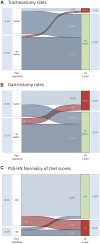Transoral Robotic Surgery for Recurrent Tumors of the Upper Aerodigestive Tract (RECUT): An International Cohort Study
- PMID: 35944904
- PMCID: PMC9552281
- DOI: 10.1093/jnci/djac130
Transoral Robotic Surgery for Recurrent Tumors of the Upper Aerodigestive Tract (RECUT): An International Cohort Study
Abstract
Background: Transoral robotic surgery (TORS) is an emerging minimally invasive surgical treatment for residual, recurrent, and new primary head and neck cancers in previously irradiated fields, with limited evidence for its oncological effectiveness.
Methods: A retrospective observational cohort study of consecutive cases performed in 16 high-volume international centers before August 2018 was conducted (registered at clinicaltrials.gov [NCT04673929] as the RECUT study). Overall survival (OS), disease-free survival, disease-specific survivals (DSS), and local control (LC) were calculated using Kaplan-Meier estimates, with subgroups compared using log-rank tests and Cox proportional hazards modeling for multivariable analysis. Maximally selected rank statistics determined the cut point for closest surgical resection margin based on LC.
Results: Data for 278 eligible patients were analyzed, with median follow-up of 38.5 months. Two-year and 5-year outcomes were 69.0% and 62.2% for LC, 71.8% and 49.8% for OS, 47.2% and 35.7% for disease-free survival, and 78.7% and 59.1% for disease-specific survivals. The most discriminating margin cut point was 1.0 mm; the 2-year LC was 80.9% above and 54.2% below or equal to 1.0 mm. Increasing age, current smoking, primary tumor classification, and narrow surgical margins (≤1.0 mm) were statistically significantly associated with lower OS. Hemorrhage with return to theater was seen in 8.1% (n = 22 of 272), and 30-day mortality was 1.8% (n = 5 of 272). At 1 year, 10.8% (n = 21 of 195) used tracheostomies, 33.8% (n = 66 of 195) used gastrostomies, and 66.3% (n = 53 of 80) had maintained or improved normalcy of diet scores.
Conclusions: Data from international centers show TORS to treat head and neck cancers in previously irradiated fields yields favorable outcomes for LC and survival. Where feasible, TORS should be considered the preferred surgical treatment in the salvage setting.
© The Author(s) 2022. Published by Oxford University Press. All rights reserved. For permissions, please email: journals.permissions@oup.com.
Figures



Similar articles
-
Treatment outcomes of transoral robotic and non-robotic surgeries to treat oropharyngeal, hypopharyngeal, and supraglottic squamous cell carcinoma: A multi-center retrospective observational study in Japan.Auris Nasus Larynx. 2021 Jun;48(3):502-510. doi: 10.1016/j.anl.2021.01.024. Epub 2021 Feb 22. Auris Nasus Larynx. 2021. PMID: 33632582
-
Transoral robotic surgery versus conventional surgery in treatment for squamous cell carcinoma of the upper aerodigestive tract.Head Neck. 2015 Sep;37(9):1304-9. doi: 10.1002/hed.23752. Epub 2014 Jul 19. Head Neck. 2015. PMID: 24816480
-
Transoral robotic surgery and neck dissection alone for head and neck squamous cell carcinoma: Influence of resection margins on oncological outcomes.Oral Oncol. 2022 Jul;130:105909. doi: 10.1016/j.oraloncology.2022.105909. Epub 2022 May 26. Oral Oncol. 2022. PMID: 35636080
-
Is transoral robotic surgery useful as a salvage technique in head and neck cancers: a systematic review and meta analysis.Head Neck. 2025 Mar;47(3):1018-1036. doi: 10.1002/hed.28021. Epub 2024 Dec 29. Head Neck. 2025. PMID: 39737644
-
Role of transoral robotic surgery in current head & neck practice.Surgeon. 2017 Jun;15(3):147-154. doi: 10.1016/j.surge.2016.09.004. Epub 2016 Oct 11. Surgeon. 2017. PMID: 27742406 Review.
Cited by
-
Functional and quality-of-life outcomes following salvage surgery for recurrent squamous cell carcinoma of the head and neck: a systematic review and meta-analysis.Eur Arch Otorhinolaryngol. 2023 Oct;280(10):4597-4618. doi: 10.1007/s00405-023-08056-z. Epub 2023 Jun 17. Eur Arch Otorhinolaryngol. 2023. PMID: 37329358
-
Salvage transoral robotic surgery in recurrent oropharyngeal carcinoma: a single-center retrospective study.Eur Arch Otorhinolaryngol. 2024 Jun;281(6):3167-3177. doi: 10.1007/s00405-024-08590-4. Epub 2024 Mar 28. Eur Arch Otorhinolaryngol. 2024. PMID: 38546850
-
Intraoperative Imaging Techniques to Improve Surgical Resection Margins of Oropharyngeal Squamous Cell Cancer: A Comprehensive Review of Current Literature.Cancers (Basel). 2023 Jan 31;15(3):896. doi: 10.3390/cancers15030896. Cancers (Basel). 2023. PMID: 36765858 Free PMC article. Review.
-
Robotic Surgery for Head and Neck Tumors: What are the Current Applications?Curr Oncol Rep. 2024 Jul;26(7):840-854. doi: 10.1007/s11912-024-01546-1. Epub 2024 May 23. Curr Oncol Rep. 2024. PMID: 38777980 Free PMC article. Review.
-
Functional outcomes of soft palate reconstruction after oncologic surgery: a systematic review and meta-analysis.Eur Arch Otorhinolaryngol. 2023 Dec;280(12):5177-5191. doi: 10.1007/s00405-023-08191-7. Epub 2023 Aug 24. Eur Arch Otorhinolaryngol. 2023. PMID: 37620732
References
-
- Brockstein B, Haraf DJ, Rademaker AW, et al. Patterns of failure, prognostic factors and survival in locoregionally advanced head and neck cancer treated with concomitant chemoradiotherapy: a 9-year, 337-patient, multi-institutional experience. Ann Oncol. 2004;15(8):1179-1186. doi:10.1093/annonc/mdh308. - DOI - PubMed

